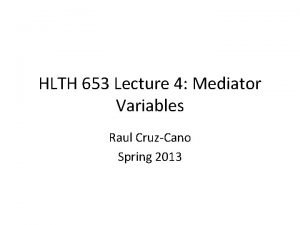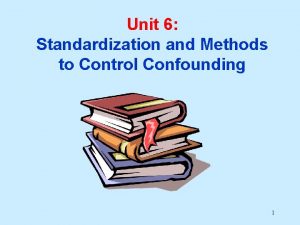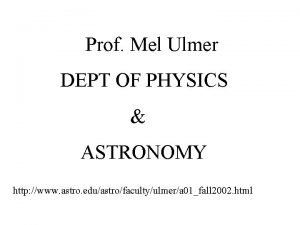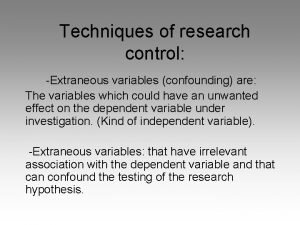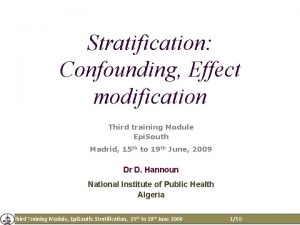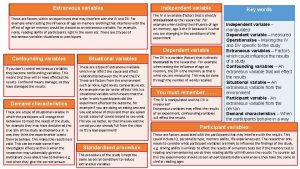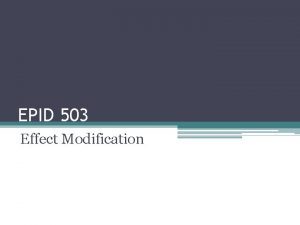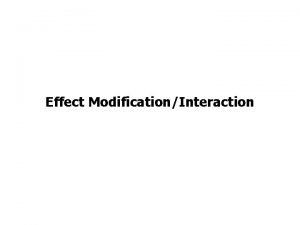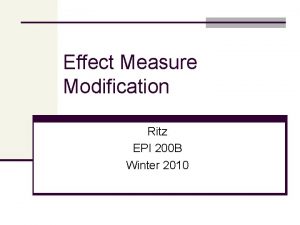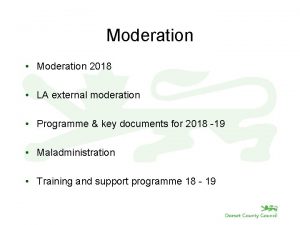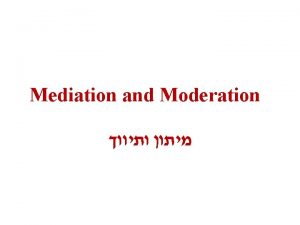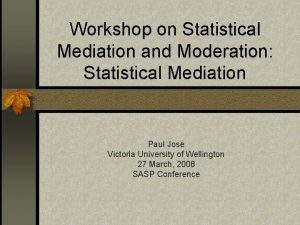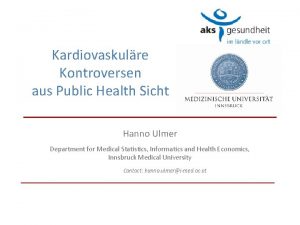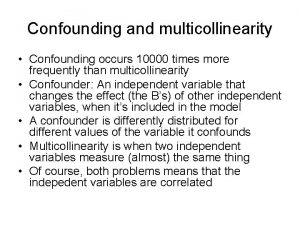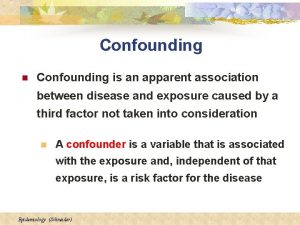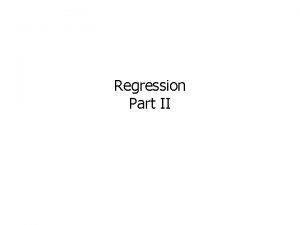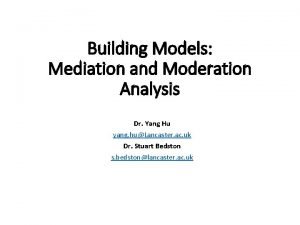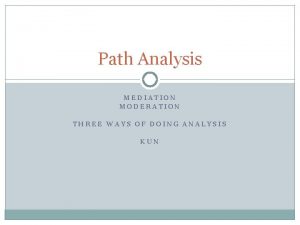Motivating Regression Analysis Confounding Mediation Moderation Hanno Ulmer

















- Slides: 17

Motivating Regression Analysis: Confounding, Mediation, Moderation Hanno Ulmer Department for Medical Statistics, Informatics and Health Economics, Innsbruck Medical University Contact: hanno. ulmer@i-med. ac. at

Regression Analysis Regression analysis is a statistical method to describe statistical associations between variables. It generalizes bivariable correlation analyses to the modeling of multivariable associations, when the focus is on the relationship between a dependent variable and one or more independent variables. Many techniques for carrying out regression analysis have been developed. The earliest form of regression was the method of least squares, which was published by Legendre in 1805, and by Gauss in 1809. 2

Widely used Regression Analyses Multivariable Analysis: Regress k independent on 1 dependent variable Dependent variable is continuous: linear regression e. g. Sex, Age, BMI -> systolic blood pressure Estimate (standardized) Beta Dependent variable is categorical: logistic regression e. g. Sex, Age, BMI -> CHD within 10 years Estimate Odds Ratio Dependent variable is time-to-event: Cox proportional hazards regression e. g. Sex, Age, BMI -> time to CHD (survival analysis) Estimate Hazard Ratio 3

Why Regression Analysis? Estimating the relationship between an exposure (e. g. risk factor, therapy) and an outcome variable (e. g. disease) is a common challenge in research. Univariable/bivariable analyses (including significance testing, correlation coeffficients) are restricted to situations where fair comparisons are forced by study designs such as randomized, controlled trials. In an optimal RCT, study groups only differ regarding the intervention (e. g. Verum vs. Placebo) This is rarely the case in observational studies. The relationship exposure – disease is usually a multivariable problem which requires techniques such as regression analysis. 4

Motivating Regression Analysis: Confounding, Moderation, Mediation Regression analysis is a multivariable statistical technique. It allows to estimate the effect of an exposure variable (e. g. BMI, obesity) on an outcome variable (e. g. a disease such as coronary heart disease (CHD) in the presence of one or more ‘third factors’ (e. g. sex, age, smoking, systolic blood pressure, cholesterol, glucose, etc. ). The impact of these third factors can be substantially different depending on the suspected causal relationships between these variables. These factors can act as confounders, moderators or mediators. The three concepts will be discussed and illustrated using the BMI --- > CHD example 5

6

Example Data Vorarlberg Health Examinations (VHM&PP) Sex (male, female) Age in years Year of Examination categorical continuous Body Mass Index in kg/m 2 Systolic Blood Pressure in mm. HG Total Cholesterol in mg/dl Fasting Glucose in mg/dl Smoking (current or past, never) continuous categorical Coronary Heart Disease Mortality (ICD-10: I 20 -I 25) time to event continuous and categorical 7

Confounding: A “mixing of the effect” of the exposure-disease relationship with a third (or more) factors BMI --------------------- > CHD < ------ Sex, Age, Smoking ----- > 8

Example Relationship between BMI and CHD incidence: Crude Hazard Ratio Obesity (30+ kg/m 2) versus Normal Weight (20 -25 kg/m 2) HR = 2. 54 95%CI (2. 32 -2. 78) Sex, age and smoking adjusting Hazard Ratio: HR = 1. 60 95%CI (1. 46 -1. 75) Adjusted means controlled for confounding Calculated with Cox proportional hazards regression analysis 9

Confounding Three essential characteristics: The confounder is associated with the exposure of interest (BMI) The confounder is associated with the disease (CHD) The confounder is not in the causal pathway leading from the exposure of interest (BMI) to the disease of interest (CHD) 10

Methods for Preventing Confounding in Study Designs Stringent inclusion criteria to narrow the variability between study participants Randomization (intervention/RCT only) Matching: Simple Matching e. g. for age and sex in case-controls studies versus Propensity Score Matching (involves logistic regression analysis) Very popular in clinical research: Blackstone EH. Comparing apples and oranges. J Thoracic and Cardiovascular Surgery 2002; 1: 8 -15. Ruttmann E, Fischler N, Sakic A, Chevtchik O, Alber H, Schistek R, Ulmer H, Grimm M. Second internal thoracic artery versus radial artery in coronary artery bypass grafting: a long-term, propensity score-matched follow-up study. Circulation. 2011 20; 124(12): 1321 -9. 11

Effect Modification/Moderation Effect modification occurs when the association between the exposure (BMI) and the disease (CHD) varies by levels of a third factor. How to assess: include interaction terms into the regression model Interaction age*obesity p<0. 001 Young: Old: BMI ----------------------------------------- > CHD 12

Example Relationship between BMI and CHD incidence moderated by age: Interaction age*obesity p<0. 001 Obesity (30+ kg/m 2) versus Normal Weight (20 -25 kg/m 2) Sex, age and smoking adjusting Hazard Ratio: <50 years of age: HR = 3. 13 95%CI (2. 27 -4. 31) 50+ years of age: HR = 1. 51 95%CI (1. 37 - 1. 66) 13

Mediation occurs if factors, like confounders, are associated with the exposure of interest (BMI) and the disease (CHD), but are in the causal pathway leading from the exposure to the disease. These factors are called mediators: BMI ---- > Blood Pressure, Cholesterol, Diabetes ---- > CHD 14

Example Mediators in the relationship between BMI and CHD incidence: Sex, age and smoking adjusting Hazard Ratio: Total effect of BMI (obesity versus normal weight) on CHD: HR = 1. 60 95%CI (1. 46 -1. 75) Direct effect of BMI on CHD HR = 1. 30 95%CI (1. 19– 1. 43) Indirect effect mediated by blood pressure, cholesterol and glucose HR = 1. 23 95%CI ( 1. 15 -1. 32) 95% CIs estimated by Bootstrap 15

Example Mediators in the relationship between BMI and CHD incidence: Effect of BMI on CHD mediated by blood pressure, cholesterol and glucose PERM (Percentage of excess risk mediated) = (1. 60 -1. 30)/(1. 60 -1)*100 = 50% (approximative formula) Global Burden of Metabolic Risk Factors for Chronic Diseases Collaboration. Metabolic mediators of the effects of body-mass index, overweight, and obesity on coronary heart disease and stroke: a pooled analysis of 97 prospective cohorts with 1· 8 million participants. Lancet. 2014 Mar 15; 383(9921): 970 -83 16

Mediation Techniques Traditional approach: Baron RM, Kenny DA. The moderator-mediator variable distinction in social psychological research: conceptual, strategic, and statistical considerations. J Pers Soc Psychol. 1986 Dec; 51(6): 1173 -82 New approaches: Lange T, Rasmussen M, Thygesen LC. Assessing natural direct and indirect effects through multiple pathways. Am J Epidemiol. 2014 Feb 15; 179(4): 5138. Vander. Weele T. Explanation in Causal Inference: Methods for Mediation and Interaction. Oxford University Press 2015. New appraoches applied on BMI --- > CHD problem: Lu Y, Hajifathalian K, Rimm EB, Ezzati M, Danaei G. Mediators of the effect of body mass index on coronary heart disease: decomposing direct and indirect effects. Epidemiology. 2015 Mar; 26(2): 153 -62. 17
 Mediator vs. moderator variable
Mediator vs. moderator variable Mediation vs moderation
Mediation vs moderation Moderating vs mediating variable
Moderating vs mediating variable How to control for confounding
How to control for confounding Mel ulmer
Mel ulmer Simple linear regression and multiple regression
Simple linear regression and multiple regression Multiple linear regression
Multiple linear regression Logistic regression vs linear regression
Logistic regression vs linear regression Logistic regression vs linear regression
Logistic regression vs linear regression Confounding variable
Confounding variable Effect modification vs confounding
Effect modification vs confounding Effect modifier
Effect modifier What is extraneous variables in research
What is extraneous variables in research Confounding variables in an experiment
Confounding variables in an experiment Why control for confounding variables
Why control for confounding variables Confounding vs effect modification
Confounding vs effect modification Effect modification vs confounding
Effect modification vs confounding Confounding vs effect modification
Confounding vs effect modification


